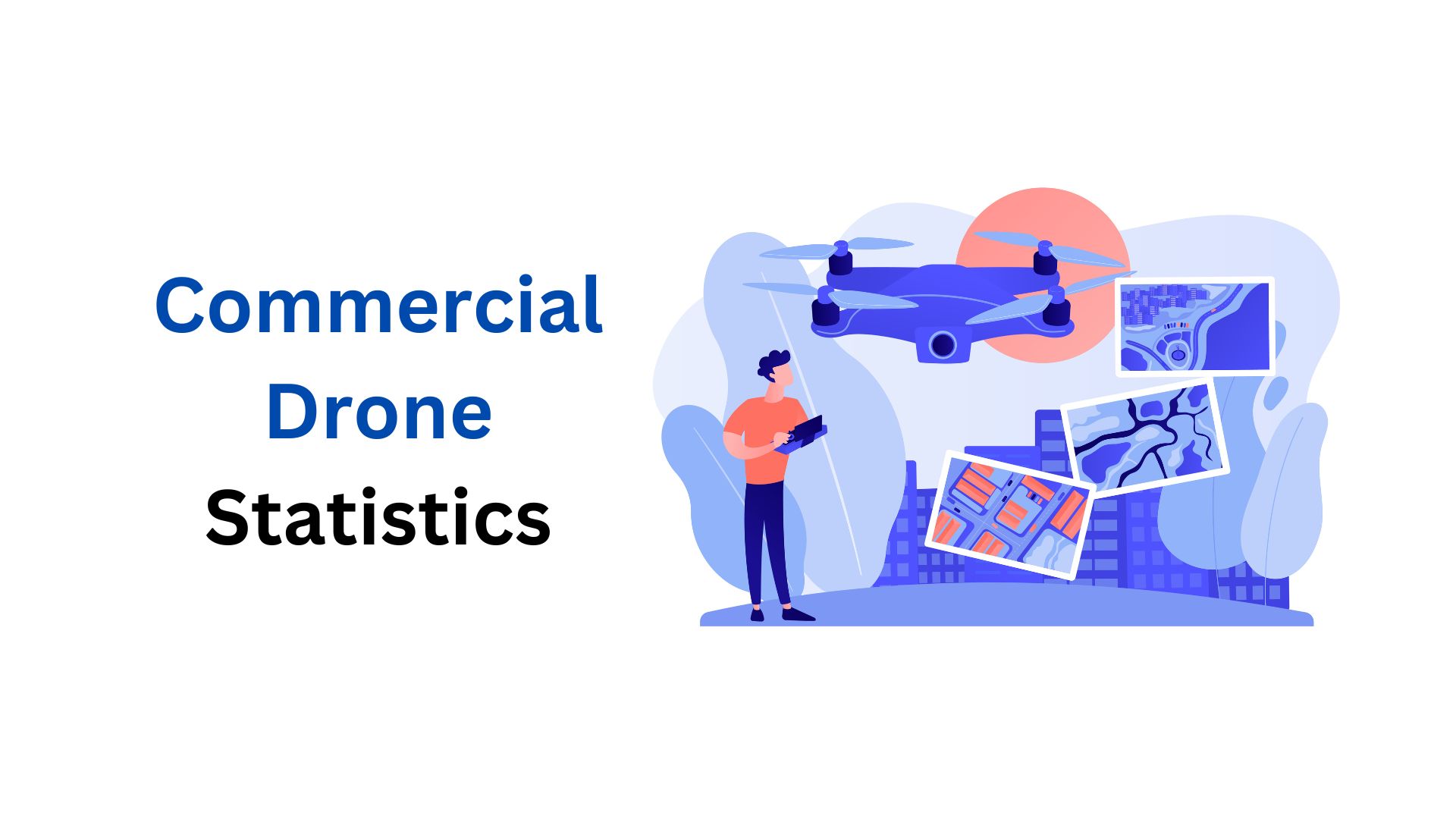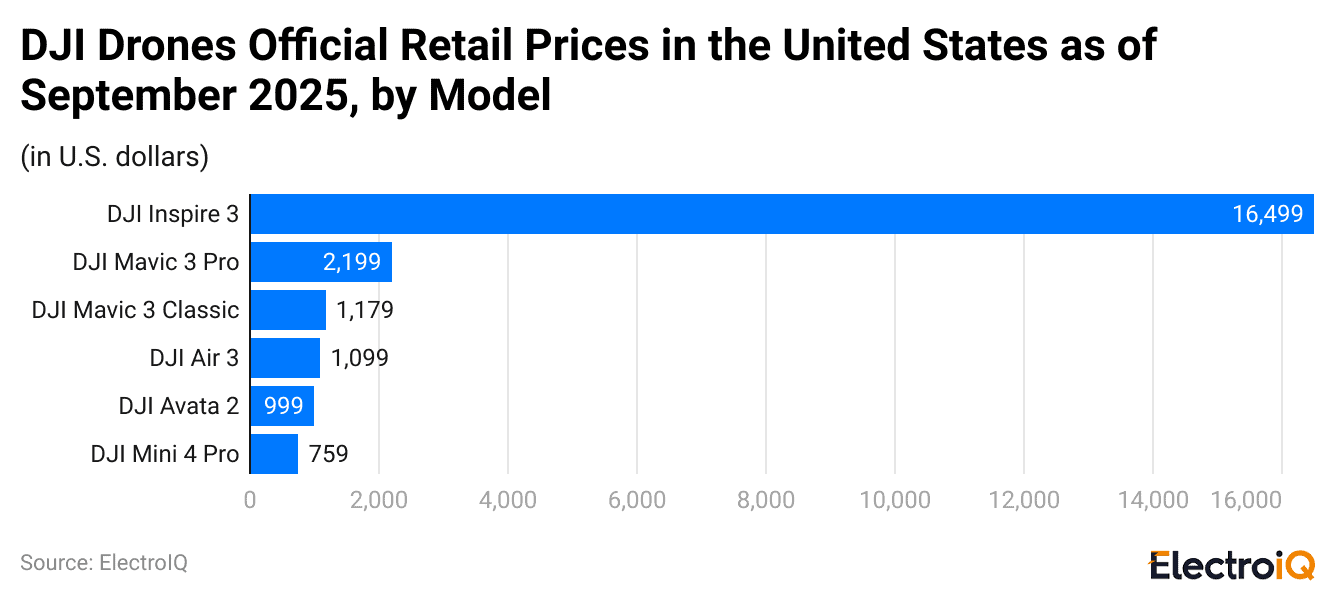Commercial Drone Statistics By Market Size, Usage and Facts (2025)
Updated · Nov 25, 2025

Table of Contents
Introduction
Commercial Drone Statistics: Commercial drones, also known as unmanned aerial vehicles (UAVs) or UAS, successfully transitioned from “experimental” to “everyday tool” in 2024. In fact, drones were actively used for companies’ inspections, mapping, farming, deliveries, and emergency services. The regulatory bodies adapted their rules accordingly, and there were continuous investments in startups through venture capital; at the same time, the company’s hardware sales branch, DJ, was heavily occupied by them.
The commercial drone industry has thus emerged as a major contributor to modern automation, with significant market growth, accelerating investment activity, and breakthrough technologies from top players such as DJI. This article will present the latest Commercial Drone statistics and their market growth.
Editor’s Choice
- The worldwide commercial drone market is set to grow at an impressive compound annual growth rate of 12.7% and to reach over USD 70 billion by 2030 and the USD 100 billion mark by 2032.
- DJI, the world’s leading drone company, has a 2023 market share of more than 70%.
- The range of DJI products spans from USD 759 (Mini 4 Pro) for beginners to USD 16,499 (Inspire 3) for professional users.
- The most costly application is industrial inspection, where drone prices range from USD 10,000 to over USD 90,000.
- A typical agricultural drone costs between USD 3,000 and USD 15,000, while mapping and surveying drones cost between USD 5,000 and USD 20,000.
- Delivery drones cost USD 5,000–USD 50,000, and the average cost of public safety drones is USD 5,000–USD 25,000.
- Media and cinematography drones are usually priced between USD 3,000 and USD 20,000.
- North America has a lion’s share of the global market, with 40% and the U.S. is the coast-to-coast ruling power within this region, with an 85% share.
- Europe commands around 30% share of the market and is projected to have 1.2 million commercial drones by 2025.
- By 2023, Skydio had achieved a USD 2.2 billion valuation and was the frontrunner in the development of AI-based autonomous navigation.
- The Global Drone Insurance Market size is expected to be worth around USD 3.5 Billion By 2033, from USD 1.5 Billion in 2023, growing at a CAGR of 8.8% during the forecast period from 2024 to 2033.
General Commercial Drone Statistics
- In the United States, the Federal Aviation Administration reported over 1.7 million registered drones and more than 203,000 certificated remote pilots, making drones one of the fastest growing transportation segments and indicating strong commercial and recreational usage.
- By the end of 2020, more than 488,000 drones had been registered specifically for commercial use in the U.S., showing that a substantial share of the overall drone fleet is already deployed for business operations such as inspections, surveying, and deliveries.
- In the U.S. Construction Survey 2024, drones were reported to be used on all projects by 45% of civil contractors, rising to 67% among larger organizations, which confirms that routine drone deployment has become standard practice for many construction firms.
- Globally, construction saw a 239% increase in drone usage between 2016 and 2018, with studies indicating project cost savings of 5% to 20% and improvements in measurement accuracy of about 61%, demonstrating how drones are being adopted to improve efficiency and data quality on sites.
- In agriculture, DJI reported that by the end of 2024 around 400,000 of its agriculture drones were in use worldwide, having treated more than 500 million hectares across over 100 countries and contributing to cumulative water savings of roughly 222 million tons, which reflects very high operational usage in farming.
- In China alone, more than 120,000 agricultural drones were used in 2021 to spray pesticides over about 175.5 million acres of farmland, indicating that drone spraying has become a large scale tool in crop protection.
- Forward looking assessments suggest that by 2025 more than 60% of farms worldwide are expected to adopt drone based surveying for data collection, which points to rapid expansion of drone usage in precision agriculture.
- For logistics and retail, the value of goods delivered to consumers by drones globally is forecast to rise from about USD 251 million in 2024 to around USD 65,177 million in 2034, implying an average annual growth of about 74% in drone based deliveries and signaling strong usage in last mile transport.
- In Australia, commercial drone activity is projected to reach about 60 million flights per year by 2043, with approximately 45.7 million flights expected in goods delivery and transport alone, while additional millions of flights are anticipated in environmental monitoring, safety and security, agriculture, construction, mining, and entertainment.
- From a service usage perspective, it was reported that in 2023 the services segment accounted for about 80.1% of the commercial drone market, compared with 16% for hardware and 3.9% for software, which indicates that most commercial spending and activity is concentrated in operational drone services rather than equipment purchases alone.
Commercial Drones Market Size

(Source: scoop.market.us)
- The global commercial drone market is projected to reach USD 125.9 billion by 2033, supported by a 29.9% CAGR between 2024 and 2033, after recording USD 9.2 billion in 2023.
- Multirotor drones held a dominant position in 2023 with more than 81% share, while fixed wing and hybrid drone types continued to serve specialized operational needs.
- The media and entertainment sector accounted for the largest industry contribution in 2023 with a 24% share, followed by agriculture and construction where drones are used for field analytics and project monitoring.
- Mapping and surveying emerged as the leading application area with more than 35% share, while aerial photography, inspections, and delivery activities were also significant contributors to overall market demand.
- Asia Pacific led the global landscape in 2023 with more than 36% share, supported by large scale commercial adoption, while North America and Europe continued to expand their operational use cases.
- Leading companies operating in the commercial drone ecosystem include DJI Technology Co. Ltd, Parrot SA, AeroVironment Inc, PrecisionHawk, and Yuneec International, along with several emerging regional participants.

(Reference: statista.com)
- DJI (Da-Jiang Innovations) is the world’s biggest and most loved drone and quadcopter manufacturer.
- The company offers a broad range of models at very different prices, accommodating a wide range of users, from novice hobbyists to professional cinematographers and commercial drone operators.
- The DJI Mini 4 Pro is an economical, entry-level option for general use, priced around 759 USD at the lower end, while the DJI Inspire 3 is at the top, priced around 16,499 USD and a high-performance, professional-grade drone.
- This vast price difference across models indicates that DJI can cater to and attract both beginners and advanced users, reflecting the company’s market power in the global drone industry.
Commercial Drones Key Players Statistics
#1. DJI (Dà-Jiāng Innovations Science and Technology Co., Ltd.)
- DJI is a Chinese technology company and the most recognized name in the global drone market.
- Founded in 2006 by Frank Wang while still a university student, DJI is young considering its age, but at the same time has grown very quickly.
- One of the company’s first steps toward success was in 2009, when DJI was able to fly a drone prototype to the top of Mount Everest, getting worldwide attention.
- The early years of the company were difficult, and it faced staffing problems as well as financial problems until an investor, Lu Di, gave USD 90,000 and helped the company stabilize its operations.
- DJI started to sell its products in Western markets in 2010 by forming DJI North America and developing its marketing strategy.
- Then came the introduction of the Phantom drone in 2013, which marked a big step forward and the launch of the Phantom 3 in 2015 with live-streaming capabilities, which completely secured DJI’s leadership in the industry.
- The company won an Emmy award in the category Technology & Engineering in 2017 for its innovation in aerial filmmaking.
- DJI’s market share reached more than 70% by 2023, and demand for its products is likely to grow significantly, potentially pushing the global UAV market to USD 55 billion by 2030 as drones’ versatile applications across sectors become increasingly accepted.
#2. Parrot
- Parrot’s headquarters is located in Paris, France, and the company was established in 1994 by Jean-Pierre Talvard, Christine/M De Tourvel, and Henri Seydoux.
- Although it initially targeted other consumer electronics markets, the company completely gave up on drones in 2017.
- Parrot emerged as a notable player when it launched its Jumping Sumo and Rolling Spider miniature drones at CES Las Vegas in 2014.
- The same year, it became a major shareholder in Pix4D and announced the AR Drone 3.0. Parrot received additional recognition in 2019 when it won a USD 11 million contract from the U.S. Department of Defence to produce reconnaissance drones.
- But over the years, the company’s revenues began to decline, reaching 54.3 million euros in 2021, down from 166.5 million euros in 2016.
#3. Yuneec International
- Yuneec is a Chinese aviation company established in 1999 in Hong Kong. The company is focusing on electric aircraft and commercial drones.
- The H520 and Typhoon H Plus are among the company’s products that are used in mapping, inspections, photography, and videography.
- In 2003, the company went global and opened offices in major cities.
- In 2010, Yuneec got worldwide recognition by winning the Lindbergh Electric Aircraft Prize, and in 2013, the E-Spyder became a certified electric aircraft.
- In 2019, the company collaborated with Leica and FLIR and developed state-of-the-art imaging and thermal camera systems for its drones.
#4. Autel Robotics
- Autel Robotics, founded in 2014, is a Chinese company that produces commercial drones.
- The most famous models created by the company are the handheld and aerial photography and filming compatible EVO II and the Dragonfish, which can be used in surveillance and search-and-rescue operations.
- The revenue from Autel in 2022 reached about USD 16 million, and the company has been steadily gaining acceptance as a producer of reliable, high-quality drones.
#5. Skydio
- Skydio, an American drone company established in 2014, has MIT alumni at the helm.
- The company made its way to the consumer market in 2018 with Skydio R1, a USD 2,500 drone featuring 12 cameras, 4K video, subject tracking, and advanced obstacle avoidance, among other things.
- In 2021, Skydio was the first U.S. drone manufacturer to achieve a valuation of over USD 1 billion.
- By February 2023, the company had collected another USD 230 million in investments, increasing its value to USD 2.2 billion.
Average Cost of Commercial Drones
- The average cost of commercial drones categorized by specific application tells what a drone services company should give priority to while buying and valuing its devices.
- For agricultural purposes, drone costs that encompass crop mapping and spraying usually fall within the USD 3,000 to USD 15,000 range.
- The features that matter most in this application are tank capacity, width of spray, and RTK (real-time kinematic) accuracy.
- Businesses usually evaluate the return on investment in terms of how many acres can be treated per hour and how much money is saved on chemicals and labour.
- Drones in mapping and surveying typically range in cost from USD 5,000 USD 20,000.
- These activities require highly accurate positioning systems such as RTK or PPK, global-shutter cameras, and, occasionally, LiDAR sensors.
- Firms generally process their clients’ costs in relation to the area measured per hectare, along with the quality of data and reports provided.
- Industrial inspection is among the most costly categories — drone prices start from USD 10,000 and can exceed USD 90,000.
- Robust safety features among others as switching systems, high-powered zoom lenses, thermal cameras, and being able to withstand strong winds, are needed for these drones.
- The pricing structure is almost similar, where payment is made for the number of assets inspected and the precision of fault or defect detection.
- Spanning delivery and logistics, typical drone prices are USD 5,000 to USD 50,000. The main factors are payload capacity, flight distance, and safety features.
- Companies should also consider the need for regulatory compliance and preparation of standard operating procedures for designated flight paths.
- Public safety applications generally see drones priced between USD 5,000 and USD 25,000.
- On the other hand, media and cinematography drones are in the price range of USD 3,000 to USD 20,000. Here, high-quality camera and image stabilization are the main factors.
- Services are mostly packaged deals with daily flight rates combined with optional post-production and editing.
- The overall picture indicates a continuous decrease in drone hardware prices every year due to the mass production of components.
- Consequently, the drone operating companies are compelled to not only focus on the cheapest drone but also to maximize the utilization of the equipment, the quality of the service, and their profit margins.
Commercial Drones Statistics By Region
North America
- According to Statista, North America is the leading region in the commercial drone market, with a share of around 40%.
- The US market, at more than 85%, is the largest in North America.
- The industry is also anticipated to boom in the near future, as reflected in the projected compound annual growth rate (CAGR) of 19.5% from 2021 to 2028.
- Such numbers reflect North America’s stronghold and being one of the major forces in the commercial drone industry in terms of innovation and adoption.
Europe
- Europe is the second-largest commercial drone market, accounting for around 30% of the global market share.
- The growth of this market is mainly driven by increased drone use across industries such as agriculture, construction, and infrastructure development.
- DroneSourced predicts that the total number of commercial drones in Europe will be 1.2 million by the end of 2025, and that it will be increasing at an enormous CAGR of 25.6%.
- This shows how fast Europe is developing in terms of its drone ecosystem, as well as the high level of technological investment that accompanies the growth.
Asia-Pacific
- The Asia-Pacific market is the fastest-growing one in the world for commercial drones, with a CAGR of 28.4% for the period 2021-2028.
- The main reason for this sudden increase in the market size is the large-scale application of drones in agriculture, construction, and infrastructure.
- China is the largest market in the Asia-Pacific region, accounting for more than 60% of the market share.
- This scenario indicates that the Asia-Pacific region is becoming more and more important in terms of drone production and usage.
Latin America
- Between 2021 and 2028, the commercial drone market in Latin America is projected to achieve a compound annual growth rate (CAGR) of 21.7%.
- The main factors contributing to this trend are the increasing adoption of drones in the agricultural, construction, and infrastructure monitoring sectors.
- Brazil is the leading market in Latin America, with a share of more than 50% of the total market.
- This indicates that various industries in Latin America are increasingly relying on drone technology.
Middle East and Africa
- Just like in other regions, the Middle East and Africa are also gradually witnessing the growth of the commercial drone market, which is anticipated to grow at a CAGR of 23.1% during the period of 2021 to 2028.
- This is happening as the various industries of construction, agriculture, and infrastructure management are adopting drones to a greater extent.
- The United Arab Emirates is the dominant country in this region, and it represents more than 40% of the entire market.
- The commercial drone industry worldwide is poised for a very bright future, with an average annual growth rate of 23.8% by the end of the same period.
Recent Developments
- The field of commercial drones has gone through a process of technological era very recently, the old one being characterized by the above-mentioned strategic acquisitions, product launches, and the overall increase in funding and technological development.
- At the beginning of 2023, AeroVironment successfully acquired Arcturus UAV for a total of USD 405 million, which was one of the steps in the company’s plan to grow its market share in agriculture and environmental monitoring in particular.
- At the beginning of 2024, with the help of MicaSense’s imaging sensor technology, AgEagle would be able to create better quality sensors for mapping and monitoring purposes in agriculture through the USD 23 million investment.
- One of the world’s leading drone manufacturers, DJI, during the summer of 2023, unveiled the Matrice 300 RTK, featuring unsurpassed flight characteristics and AI-based functionalities along with a wide range of payload options for surveying, inspection, and public safety, among other applications.
- With a focused approach for emergencies and business customers, Parrot, with its ANAFI USA, went for a launch in the first quarter of 2024, which included thermal imaging, powerful zoom, and ruggedness for harsh environments.
- The financial market for these companies has not been affected by the economic conditions and has remained strong.
- Skydio in 2023 managed to collect USD 170 million for the further development of its autonomous drones powered by AI, and Zipline got USD 250 million in 2024 for extending its delivery services, especially in the medical and logistics fields.
- Throughout the industry, technology development is a driving force, and AI, machine learning, and 5G are the main technologies that increase the communication between the operator and the drone in terms of real-time navigation and data processing.
- On the one hand, the FAA’s Remote ID rule and the EU’s U-space framework are enabling smoother and more secure drone operations.
- Research efforts are also accelerating in areas like drone swarming, LiDAR, and hyperspectral imaging, supporting more advanced commercial applications.
Conclusion
Commercial Drones Statistics: The commercial drone industry is undoubtedly set for a new era of growth up to the distant future; besides, supporting factors are the technological advancement, an influx of finance, and the intensifying demand in agriculture, logistics, infrastructure, and public safety. The growth patterns from different regions indicate that the adoption is extensive, while the major enterprises and the start-ups continue to explore the advanced AI navigation, thermal imaging, and real-time data processing.
The companies that will stand out in the market are those that put their focus on service quality and the efficient use of drone technology as the hardware costs decline and regulations become clearer.
FAQ.
The commercial drone market is growing at a compound annual growth rate (CAGR) of roughly 12.7%, and the forecast indicates that it could exceed US$70 billion by 2030 and rise to more than US$100 billion by 2032.
DJI accounts for over 70% of the global drone market primarily due to its heavy reliance on innovation, a wide range of products, and superb quality. The company caters to all levels of users from amateurs to professionals, with the prices starting from around US$759 for the basic model and going up to more than US$16,000 for the top-notch professional drones.
The cost of a commercial drone is mainly determined by its application’s purpose. Drones used in agriculture generally fall in the price bracket of US$3,000 to US$15,000, while the mapping and surveying drones are priced at US$5,000 to US$20,000. The industrial inspection drones with advanced sensors and safety systems may even cost above US$90,000. The price range for delivery drones is US$5,000 to US$50,000, and that for public safety drones is US$5,000 to US$25,000, whereas the media and cinematography drones generally cost between US$3,000 and US$20,000.
North America is the leading region of the global market for commercial drones, with an approximately 40% share, and the US is responsible for more than 85% of the demand in that region. The main factors influencing this region’s supremacy are the quick adoption of technology, the high investments in research and development, and the strong demand from various sectors.
Innovative activities supported by recent mergers, new products, and funding rounds are taking place in the drone industry at a fast pace. The companies are employing various technologies, such as AI, machine learning, thermal imaging, LiDAR, and 5G, to enhance the performance and autonomy of drones. Moreover, the implementation of regulations like the FAA’s Remote ID rule and Europe’s U-space framework is not only making the airspace safer but also allowing the structured growth of the industry.

I hold an MBA in Finance and Marketing, bringing a unique blend of business acumen and creative communication skills. With experience as a content in crafting statistical and research-backed content across multiple domains, including education, technology, product reviews, and company website analytics, I specialize in producing engaging, informative, and SEO-optimized content tailored to diverse audiences. My work bridges technical accuracy with compelling storytelling, helping brands educate, inform, and connect with their target markets.










